ABSTRACT
This study examined the Production and Market Acceptance of Coconut Residue Pancakes conducted at Nasugbu East Senior High School. Descriptive research design was used in the study to explain its overall conclusions. The sample population for this study consists of forty-two (42) teachers. The conclusion implies that coconut residue can be incorporated on pancake recipes and serves as a healthier option than traditional pancakes.
Respondents revealed that coconut residue pancakes have several health benefits and vitamins compared to the traditional pancakes. Also, coconut residue pancakes exceed the consumers impression and satisfied with the overall outcome of coconut residue pancakes.
Moreover, the researchers recommended that market should accept and recognize coconut residue pancakes as an inclusion in several food products for consumer interests.
Moreover, Coconut residue should be incorporated to pancake recipes for a more healthier pancake option. And, coconut residue should be incorporated into recipes of TVL Commercial Cooking Students.
INTRODUCTION
Coconut, also known as the “tree of life” in the Philippines (Cocos Nucifera), is a member of the palm family (Arecaceae). It is known for being one of the most useful trees in the world because the entire tree can sustain human life. Coconut is rich in minerals, iron, magnesium, zinc, manganese, copper, and selenium, making it a nutrient-rich food, and is long been used for different culinary practices.
According to Vishwakarma et. al. (2022), Coconut is an excellent source of energy, dietary fiber, and calcium. It also presents several biologically active components like sugars, proteins, free amino acids, vitamins, minerals, and growth-promoting factors.
Furthermore, Terana (2023) created tart recipes with varying concentrations of coconut. The research showed that coconut can effectively be incorporated to pastry recipes, and that the higher the amount of incorporated coconut into tart or baked recipes, the higher the acceptability level of the recipe.
Likewise, the Coconut Coalition of the Americas (2021) stated that coconut can be paired in any exotic ways and pairs well with copious amounts of flavor enhancing foods ranging from spices to savory salts and even to deliciously sweet sugars for either main dishes, snacks, or additions to meals.
In Addition, Kumar et. al. (2024) found in the research that coconuts are increasingly being recognized around the world even in regions that do not cultivate them and witnessed a surge in research and commercial interest considering the inclusion of coconut as an ingredient in several food products.
Researchers from Nasugbu East Senior High School aim to investigate the production and market acceptance of Coconut residue pancakes. They will attempt to address the following inquiries: 1.) What is the nutritional value of coconut residue pancakes compared to traditional pancake option; 2.) What is the market acceptance and consumer preference for coconut residue pancakes in terms of taste, price, and overall willingness to purchase; 3.) How can TVL commercial cooking students effectively incorporate coconut residue into pancake recipes?
In lieu thereof, the researchers utilized the descriptive research design to determine production and market acceptance of Coconut residue pancakes among different consumers at Nasugbu East Senior High School. The findings were the bases for developing a recipe that will provide valuable insights into the production and market acceptance of Coconut residue pancakes, paving the way for a successful product launch.
METHODOLOGY
The study adopted a descriptive research design with a quantitative approach. Exploring the feasibility and potential impact of introducing “Coconut Residue Pancakes”. Based on voxco.com (2021), descriptive research design is a type of research design that aims to systematically obtain information to describe a phenomenon, situation, or population.
The study was conducted in Nasugbu East Senior High School located at Brgy. Lumbangan, Nasugbu, Batangas. The school has been founded since 2016 headed by Principal Il with fifty-one (51) teachers and five (5) non-teaching staff. To ensure representative samples, the researchers selected forty-two (42) teachers as respondents using Slovin’s formula. Slovin’s formula is used to calculate the sample size necessary to achieve a certain confidence level of 95 percent and Precision Level or margin of error of 5 percent After thorough study of the problem, the respondents were chosen using Simple Random Sampling (SRS) which involves selecting individuals from the population in such a way that every individual has an equal chance of being chosen. This sampling method has an equal and likely possibility of getting selected in the sample. Since the selection of item completely depends on the possibility, therefore this method is called “Method of chance Selection”.
Data collection primarily relied on a survey questionnaire administered to the selected students. This questionnaire included both closed-ended and Likert scale questions, covering aspects such as awareness of health benefits, overall willingness to purchase product, and feedback on products’ taste and price.
Ethical considerations, such as informed consent, confidentiality, and voluntary participation, were strictly adhered to throughout the research process.
To analyze the feasibility study of the product and collect data, the researchers conducted the survey through direct dissemination of the questionnaires. The questionnaire design includes a cover letter explaining the study’s purpose and ensuring strict confidentiality between researchers and respondents.
The Likert scale questions were coded and analyzed using descriptive statistics, including percentages, weighted means, and standard deviation. The findings were presented through tables, facilitating further analysis and comparison.
RESULTS AND DISCUSSION
This part presents the data gathered, analyses and interpretation to answer the problem which this study aims to achieve.
1. The Nutritional Benefits of Coconut Residue Pancakes Compared to Traditional Pancakes
Table 1 presents the Nutritional Benefits of Coconut Residue Pancakes Compared to Traditional Pancakes. Based on the ten (10) indicators which are presented to the respondents during the conduct of the survey, the highest Weighted Mean is the respondents’ answers regarding coconut residue pancakes as a healthier option compared to traditional pancakes with weighted mean of 3.71 (SD=3.22), qualitatively describes as Strongly Agree. This means that coconut residue pancakes provide several vitamins and health benefits compared to traditional pancakes. However, coconut residue contributes to boosting metabolism has the lowest weighted mean of 3.62 (SD=3.12) which means coconut residue has essential nutrients that enhances the energy of the body. This indicator is qualitatively described as Strongly Agree.
Overall results show that the respondents mark “strongly agree” on the nutritional benefits of coconut residue pancakes compared to traditional pancakes with grand weighted mean of 3.67 (SD=3.18).
This result is related to the study conducted by Vishwakarma et. al. (2022) who revealed that coconut is an excellent source of energy, dietary fiber, calcium, and presents several biologically active components like vitamins and minerals. This explained that coconut residue pancakes can be a healthier option compared to traditional pancakes.
Table 1 The Nutritional Benefits of Coconut Residue Pancakes Compared to Traditional Pancakes
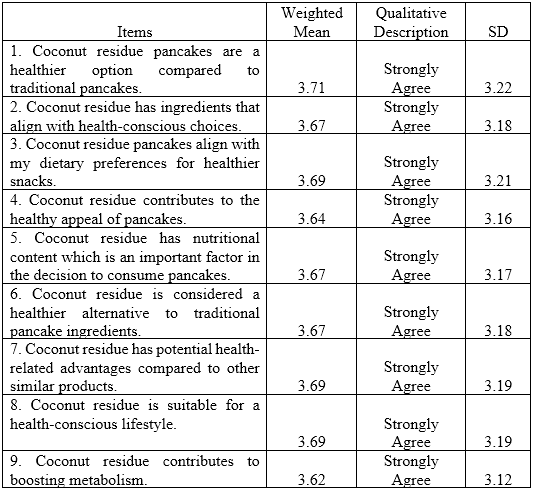

2. Market Acceptance and Consumer Preference for Coconut Residue Pancakes
2.1 Taste
Table 2.1 presents the Market acceptance and consumer reference for coconut residue pancakes in terms of taste. Based on the five (5) indicators which are presented to the respondents during the conduct of the survey, the highest Weighted Mean is the respondents’ answers regarding the pleasant taste and appeal of coconut residue pancakes with mean of 3.69 (SD=3.18/3.22), qualitatively describes as Strongly Agree. This means that coconut residue pancakes exceed the consumers’ impression. However, the taste of coconut residue pancakes meets their expectations has the lowest weighted mean of 3.60 (SD=3.17) which means coconut residue needed to improve more to satisfy and meet the consumer’s expectations in terms of taste. This indicator is qualitatively described as Strongly Agree.
Overall results show that the respondents mark “strongly agree” on the market acceptance and consumer preference for coconut residue pancakes in terms of taste with grand weighted mean of 3.65 (SD=3.15).
This result is related to the study conducted by the Coconut Coalition of the Americas (2021) who revealed that coconut can be paired in many exotic ways even to deliciously sweet sugars like snacks. This explained that coconut residue can effectively be paired to pancake recipes and enhance its taste and satisfy the consumer’s taste buds.
Table 2.1 Market Acceptance and Consumer Preference for Coconut Residue Pancakes in Terms of Taste
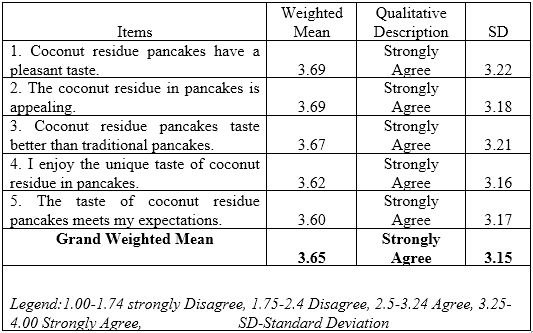
2.2 Price
Table 2.2 presents the Market acceptance and consumer reference for coconut residue pancakes in terms of price. Based on the five (5) indicators which are presented to the respondents during the conduct of the survey, the highest Weighted Mean is the respondents’ answers regarding the good value of coconut residue pancakes for money with mean of 3.60 (SD=3.1), qualitatively describes as Strongly Agree. This means that the price of the coconut residue pancakes aligns and meet with the consumer ability to purchase. However, consumers are willing to pay premium for coconut residue pancakes and its price is competitive has the lowest weighted mean of 3.45 (SD=2.98) which means the price are not that suitable or desiring compared to traditional pancakes. This indicator is qualitatively described as Strongly Agree.
Overall results show that the respondents mark “strongly agree” on the market acceptance and consumer preference for coconut residue pancakes in terms of price with grand weighted mean of 3.51 (SD=3.03).
This result is related to the study conducted by Kumar et. al. (2024) who revealed that there are a surge in commercial interest considering the inclusion of coconut as an ingredient in several food products. This explained that coconut residue can be paired with traditional pancake recipes and add to the commercial and consumer interests.
Table 2.2 Market Acceptance and Consumer Preference for Coconut Residue Pancakes in Terms of Price
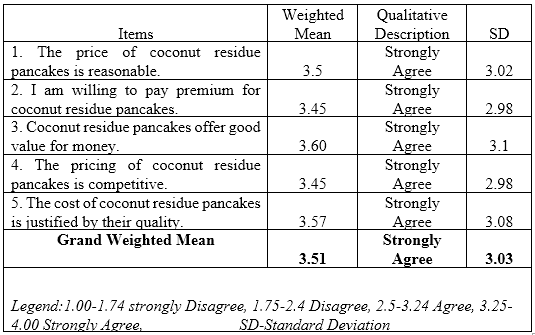
2.3 Overall Willingness to Purchase
Table 2.3 presents the Market acceptance and consumer reference for coconut residue pancakes in terms of overall willingness to purchase. Based on the five (5) indicators which are presented to the respondents during the conduct of the survey, the highest Weighted Mean is the respondents’ answers regarding recommending coconut residue pancakes to others and satisfaction with the overall experience of coconut residue pancakes with mean of 3.67 (SD=3.16), qualitatively describes as Strongly Agree. This means that coconut residue pancakes meet the consumer’s standards and market interest. However, the coconut residue pancake as a preferred choice has the lowest weighted mean of 3.60 (SD=3.11) which means coconut residue can improve more to excel in consumer preference. This indicator is qualitatively described as Strongly Agree.
Overall results show that the respondents mark “strongly agree” on the market acceptance and consumer preference for coconut residue pancakes in terms of overall willingness to purchase with grand weighted mean of 3.64 (SD=3.14).
This result is related to the study conducted by Kumar et. al. (2024) who revealed that coconut is increasingly being recognized around the world as an inclusion in several food products for the consumer interests. This explained that coconut residue can effectively be paired with pancake recipes to meet the consumer interests and preferences for food products.
Table 2.3 Market Acceptance and Consumer Preference for Coconut Residue Pancakes in Terms of Overall Willingness to Purchase
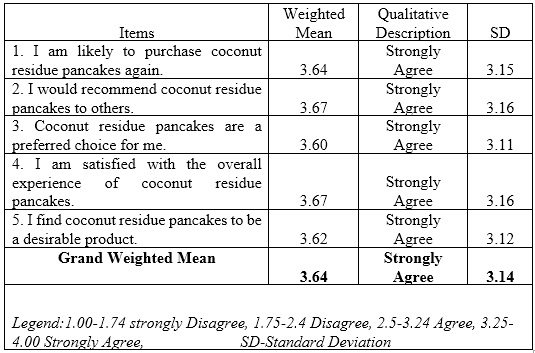
3. Effective Incorporation of Coconut Residue into Recipes by TVL Commercial Cooking Students
Table 3 presents the effective incorporation of Coconut residue into recipes by TVL Commercial Cooking Students. Based on the five (5) indicators which are presented to the respondents during the conduct of the survey, the highest Weighted Mean is the respondents’ answers regarding the incorporation of coconut residue into pancake recipes with a mean of 3.79 (SD=3.28), qualitatively describes as Strongly Agree. This means that coconut can effectively be incorporated into pancake recipes. However, the coconut residue maintains its flavor and texture when baked in pancakes and it complements other ingredients in pancake recipes have the lowest weighted mean of 3.14 (SD=3.37, 3.33) which means coconut residue needed to be incorporated well to create a fusion and complement the other ingredients of the recipe. This indicator is qualitatively described as Strongly Agree.
Overall results show that the respondents mark “strongly agree” on the effective incorporation of coconut residue into recipes by TVL Commercial Cooking Students with grand weighted mean of 3.49 (SD=3.28).
This result is related to the study conducted by Terana (2023) who revealed that coconut can effectively be incorporated to pastry . This explained that coconut residue can effectively be incorporated to pancake recipes to create a fusion and unique taste compared to traditional pancakes.
Table 3 Effective Incorporation of Coconut Residue into Recipes by TVL Commercial Cooking Students
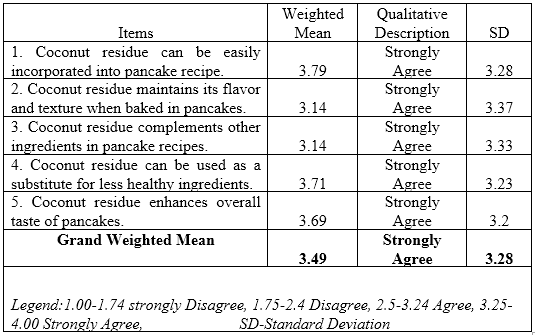
CONCLUSIONS AND RECOMMENDATIONS
This part presents conclusions and recommendations of the study.
CONCLUSIONS
Based on results of the study, the following conclusions are drawn:
1. Respondents strongly agree on the nutritional value of coconut residue pancakes and as a healthier option compared to traditional pancakes.
2. Coconut residues are proposed to be incorporated to pancake recipes and have obtained the market acceptance and consumer preference in terms of taste, price, and overall willingness to purchase.
3. TVL Commercial Cooking Students can effectively incorporate coconut residue into pancake recipes.
RECOMMENDATIONS
Based on proceeding findings and conclusions the following recommendations are offered by the researchers:
1. Coconut residue should be incorporated to pancake recipes for a more healthier pancake option.
2. Market should accept and recognize coconut residue pancakes as an inclusion in several food products for consumer interests.
3. Coconut residue should be incorporated into recipes of TVL Commercial Cooking Students.
BIBLIOGRAPHY
1 : Coconut Coalition of the Americas. (2024, February 23). Home 2.0 - Coconut Coalition of the Americas. https://coconutcoalition.org/using-coconut-with-recipes-and-foods/Ewi87qeJhveHAxVhrlYBHX2pHb0QFnoECBEQAQ&usg=AOvVaw1vAGnwN19jMVM9KzdJ7RrY
2 : Kumar, S. A., Negi, A., Santhoshkumar, P., Moses, J. A., & Sinija, V. R. N. (2024). Coconut: Expanding avenues in processing and an exposition on non‐conventional value‐added products. Journal of the Science of Food and Agriculture. https://doi.org/10.1002/jsfa.13764
3 : Terana, C. C. (2023). Acceptability of coconut (Cocos nucifera) apple tart filling recipe: Techno guide for Extension program. Journal of Applied and Natural Science, 15(2), 542 - 548. https://doi.org/10.31018/jans.v15i2.4451
4 : Vishwakarma, S., Dalbhagat, C. G., Mandliya, S., & Mishra, H. N. (2022). Investigation of natural food fortificants for improving various properties of fortified foods: A review. Food Research International, 156, 111186. https://doi.org/10.1016/j.foodres.2022.111186
5 : Voxco. (2021, September 29). What is Descriptive Research Design? Voxco. https://www.voxco.com/blog/descriptive-research-design/
COCONUT RESIDUE PANCAKE RECIPE
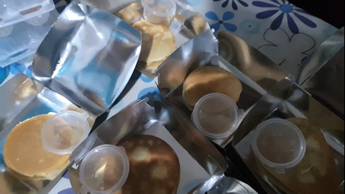
INGREDIENTS:
Oil
For the Batter:
2 eggs
3 teaspoon Milk
1 teaspoon Coconut milk
3⅓ Tablespoon All-purpose flour Sugar
¼ teaspoon Vanilla Extract
For the Filling:
3 Tablespoon All-purpose flour
¼ teaspoon Salt
¼ cup White sugar
2 eggs
½ cup Milk
½ cup Coconut milk
1 cup Coconut Residue
2 Tablespoon Unsalted butter
2 teaspoon vanilla extract
PROCEDURE:
- For the filling: In a saucepan, put the All-purpose flour, salt, sugar, eggs, milk, coconut milk and coconut residue. Cook under medium low heat while gradually mixing. Once cooked, remove from the pan and mix in butter and vanilla extract. Let it cool and set aside.
- For the Batter: Separate the egg whites from egg yolks and set aside the egg whites. Pour the milk and coconut milk into the egg yolks, mix and then add the All-purpose flour and vanilla extract. Set aside.
- As for the reserved egg whites, beat it using electric mixer and gradually add sugar forming a meringue. Then, fold in the batter into the meringue mixture using a rubber spatula.
- To Cook the Pancake: In a pan, brush some oil. Over low heat, put some batter mixture onto the pan. When firm enough, add the filling and pour a small amount of the batter on top before flipping it. Once the pancake is cooked evenly on both sides, remove from the pan.
- Serve and enjoy.